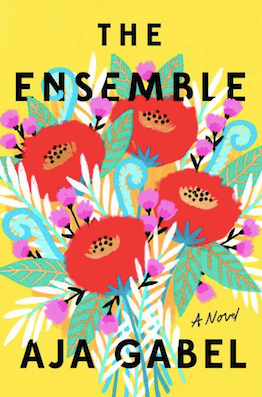The Ensemble: Aja Gabel’s Novel About a String Quartet Reveals the Violent Cost of Music

The Ensemble is the tale of a string quartet, with author Aja Gabel playing the social and musical strings which bind them. The novel contains numerous passages suffused with music, and while Gabel’s prose takes flight during these performances—alighting upon notes and measures, the tips of bows and fingers and artistic icebergs binding her quartet as much as the music does—they are not the most powerful sections in the book. That honor belongs to Gabel’s nods to the pain art requires; not mental and emotional pain, but bodily and mechanical.
The physical movements.
 Music is, at its core, an inherently violent activity. It is produced by striking and sawing, plucking and scraping, strangling out of an instrument a specific cry. And the instruments fight back! They inflame and eat away at joints, elbows, wrists, fingers. They fill cysts, curve shoulder blades, slip discs, attack the body in myriad ways.
Music is, at its core, an inherently violent activity. It is produced by striking and sawing, plucking and scraping, strangling out of an instrument a specific cry. And the instruments fight back! They inflame and eat away at joints, elbows, wrists, fingers. They fill cysts, curve shoulder blades, slip discs, attack the body in myriad ways.
To create such art is to reckon with a physical cost. And while some require more extravagant and obvious dues than others, all come for their pound of flesh. A professional musician must hew from their minds, souls and extremities a second person—a different person, one for whom discomfort and fatigue are mere words. They must produce the actions required of them with the unconscious viciousness of an apex predator and the practiced precision of an industrial robot.
Musicians carve deep canals through the topographic tips of their fingers. They fight through aches and the fog of painkillers, dedicating countless hours and unfathomable physical repetitions to assuring that when they play, they are in harmony not only with each other, but with themselves, body and mind.
And how cruel the corporeal symphony! It will inevitably devour any and all who play it, dissolving its adherents at the joints. Naked nerves and medical interventions are the cost of perfection, which for the caliber of professional musician populating Gabel’s novel—violinists, violists, cellists—is the baseline for entry. No amount of dedication or supplication before music or art or harmony will alleviate the physical toll required; no beauty can overcome mechanical action, at least not indefinitely.
Gabel’s musicians are struck like a chord, interpersonal pains and private neurosis filling in the rests between the notes. They surrender themselves to each other and to the music. Her exploration of their pain comes intermittently, with little warning and lasting consequences, like injury itself, but it lingers longer than the tired beats of relationships.
What more intimate relationship exists, after all, than the one between owner and body? The Ensemble reveals this relationship to be rich in horror and honor, a harmony of sacrifice, the sheer exhaustion of performing stretched across the staff as a rack, music notes written in blood.
B. David Zarley is a freelance journalist, essayis, and book/art critic based in Chicago. A former book critic for The Myrtle Beach Sun News, he is a contributing reporter to A Beautiful Perspective and has been seen in The Atlantic, Hazlitt, Jezebel, Chicago, Sports Illustrated, VICE Sports, Creators, Sports on Earth and New American Paintings, among numerous other publications. You can find him on Twitter or at his website.







































